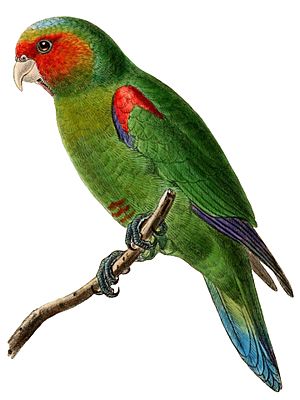Red-faced parrot facts for kids
Quick facts for kids Red-faced parrot |
|
|---|---|
 |
|
| Conservation status | |
| Scientific classification | |
| Genus: |
Hapalopsittaca
|
| Species: |
pyrrhops
|
 |
|
The red-faced parrot (scientific name: Hapalopsittaca pyrrhops) is a special type of parrot. It is part of the Psittacidae family, which includes many different kinds of parrots. This bird gets its name from the bright red feathers on its face.
Contents
Where the Red-Faced Parrot Lives
The red-faced parrot lives in only two countries: Ecuador and Peru. You can mostly find them in the eastern Andes Mountains in southern Ecuador. They also live in the northwest part of Peru.
These parrots prefer to live in mild forests. In Ecuador, they are found in areas like Azuay, Loja, and Morona-Santiago. In Peru, they live in the Piura department.
Their natural habitat is in subtropical or tropical moist mountain forests. They have also been seen living in bushy areas next to high-altitude grasslands called páramo. One important place for them is Selva Alegre, which has the largest group of red-faced parrots.
Why the Red-Faced Parrot Is Endangered
Sadly, the red-faced parrot is an endangered species. This means its population is shrinking fast. The biggest reason for this is habitat loss. Their homes are disappearing.
Studies in southern Ecuador show that these parrots mostly live in cloud forests in Selva Alegre. These cloud forests are being cut down. People are clearing the land for grazing animals and for farming. This leaves the red-faced parrots with fewer places to live.
The number of red-faced parrots in Selva Alegre is quite small. Scientists estimate there are between 169 and 734 birds. These birds usually stay in groups of about 20. Because they tend to stay in one area, losing their habitat is very dangerous for them. A small population also means fewer birds can mate and have babies. This makes the species even more at risk.
Red-Faced Parrot Reproduction
The best time for red-faced parrots to have babies is from August to January. They build their nests in trees. Usually, a female parrot will lay two or three eggs. Scientists are still learning a lot about how these parrots raise their young.
What Red-Faced Parrots Eat
Red-faced parrots eat a variety of foods in their forest homes. Their diet includes different flowers and seeds. They also enjoy fruits from miconia plants and viburnum berries. They eat young shoots from weinmannia trees and parts of ericaceous trees.
How Red-Faced Parrots Communicate
The red-faced parrot has a special call it makes when flying. It sounds like repeated "chek-chek...chek-chek" or "chek-chek-chek…". When they are sitting on a branch, they make other sounds. These include nasal calls, like "kyek" and "crreet". These calls help them find other parrots in their flock.
Images for kids
See also
 In Spanish: Lorito ecuatoriano para niños
In Spanish: Lorito ecuatoriano para niños




